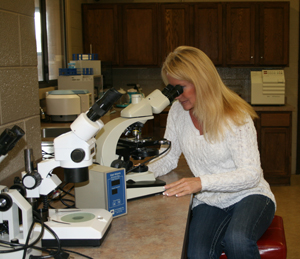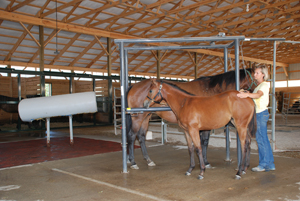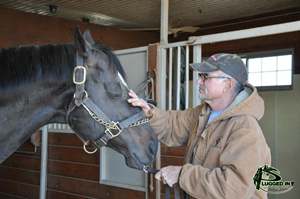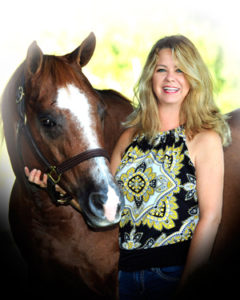 As falling leaves turn trees bare and the cold winter air sets in, the holidays are upon us and before we know it, we will be ringing in a new year and a new breeding season.
As falling leaves turn trees bare and the cold winter air sets in, the holidays are upon us and before we know it, we will be ringing in a new year and a new breeding season.
So, what key concepts should mare owners know to ensure their breeding season is both enjoyable and successful
According to reproduction specialist, David Scofield, DVM, MS, DACT of Select Breeders Service- Veterinary Service, Chesapeake City, Maryland, mare owners should follow a four-step guide of nutrition, cyclicity, health status, and reproductive status.
“First, you want your mare to be on an increasing plane of nutrition and be in adequate body condition. However, you don’t want your mare too fat,” he says.
Then, Scofield suggests lighting as the most reliable method to get your mare to cycle early.
“Using a mare’s natural physiology by increasing exposure to periods of light is the best method. I suggest jump starting your mares’ first cycles of the year by putting them under lights 16 hours a day 60 days prior from the time you would like to start breeding,” he says.
Although there are certain drugs that veterinarians can use to get mares to cycle early, Scofield does not feel that they are completely reliable and strongly urges the use of lighting first and foremost.
“A 100 watt bulb per 12-foot stall (to produce 10 foot-candles of illumination) is enough light to stimulate your mare’s endocrine system to begin to cycle,” he says.
Next, Scofield suggests mare owners get their mares’ health status up to date prior to breeding time.
“You want to get vaccinations, teeth, and shoeing all out of the way before you start breeding,” he explains. “I don’t like to give mares any shots until they are at least 60 days in foal.”
 Finally, you want to be up on your mare’s reproductive status.
Finally, you want to be up on your mare’s reproductive status.
“If you have a mare that you know is a problem, you want to start early so your veterinarian has time to start with diagnostics and therapy before it gets too late in the season,” he says.
For maiden mares, Scofield suggests discussing with your veterinarian whether your mare may or may not need a culture depending on the discipline and whether you are breeding by live cover, using cooled semen, or frozen semen.
“With foaling mares, you want to make sure there are no problems that occurred during foaling. Cervical issues are often hidden so you want to be certain there are no abnormalities post foaling,” he says.
Also, if you have a mare that has a caslick opened for foaling, Scofield recommends replacing it within a week or 10 days to give time for tissue to repair and for fetal fluids to pass.
Beyond Scofield’s four-step guide, he also stresses the importance of having an early plan with your veterinarian.
“You want to make sure all your paperwork is in order. For example, you want breeding contracts in order, fees paid, and be conscious of having your shipping methods set up. You should know collection days from the breeding farm you are working with and know if counter to counter service and if Saturday FedEx delivery is available in your area,” he says.
If you are planning on competing later in the year, Scofield then sets up earlier cycles for those wanting earlier foals.
 “You should keep in mind pregnant mares who are under lights on average foal 10 days earlier, which can help in getting your mare back in foal as early as possible,” he says.
“You should keep in mind pregnant mares who are under lights on average foal 10 days earlier, which can help in getting your mare back in foal as early as possible,” he says.
When setting up foaling mares for embryos, Scofield prefers to short cycle rather than breed on a foal heat. However, some mares who meet certain criteria can reproduce on foal heats, which can also help in getting an earlier turn around for re-breeding.
“The biggest misconception that I find with novice breeders is that even normal mares can have an inflammatory response to sperm,” he says. “Most mares will clear the inflammatory response in 24 hours but abnormal mares do not. The mare owner needs to figure out which their mare is and the best, most effective way to treat her. Some mares are harder to treat then others.”
Above all, Scofield stresses having a veterinarian who you are comfortable with asking questions. He suggests discussing your breeding questions in depth and asking why your veterinarian is doing something a certain way.
“Breeding is a business for some and for others it’s a hobby. Either way, breeding should be an enjoyable experience for all involved,” he says.
Debbi Trubee, farm manager at Pine View Farms, North Lawrence, Ohio starts prepping mares early.
“You need to keep your mare under lights 16 hours a day starting around Dec 1. It really matters that you bring your mares in before it gets dark outside. You need to put your lights on timers and make sure lights are out at night,” she says.
Next, Trubee suggests checking your mare’s cycle early in mid-January.
“Make sure your mare had a full cycle not just a transitional one,” she says. “Older mares often require cultures. Many maiden mares do not, but you need to be aware of where your mare is at before you get ready to breed.
Although Trubee does not have a preference for onsite breeding at the farm versus shipping semen, the biggest challenge she finds with mare owners at home is checking for ovulation post breeding.
“Many people do not understand just because a mare has a big follicle does not mean she ovulated,” she says.
In addition, Trubee feels mare owners who have any suspicions of their mare having low progesterone levels should put their mares on Regumate post ovulation and then on progesterone injections post heartbeat.
“Regumate is cheap insurance if your mare has low progesterone levels,” she says.
Also, Trubee suggests getting organized early with paperwork you need for breeding.
“At Pine View, we are an USDA approved International Collection Center for Europe and Australia. You need to know collection days and arrival days in your area as well as having all the necessary documentation. Shipments to Canada require a lot of documentation as do frozen shipments overseas,” she says.
Trubee likes to keep her mares fat throughout their pregnancy.
“Your mares need to be fed with good quality hay and grain. Groceries effect the baby all through the mare’s pregnancy, so good nutrition helps ensure a healthy baby,” she says.
 Milt Alderman, of Royal Vista Ranches, Wayne Oklahoma, a longtime breeding manager, trainer, and AQHA judge,says he feels early breeding preparation is key to breeding success.
Milt Alderman, of Royal Vista Ranches, Wayne Oklahoma, a longtime breeding manager, trainer, and AQHA judge,says he feels early breeding preparation is key to breeding success.
“We first light our mares Dec. 1. You want to make sure your mare has eight hours of darkness. We also make sure our mares get plenty of exercise. Providing weather, they go out every day as do our stallions,” he says.
Alderman stresses keeping broodmares up in good health just like show horses.
“You want your horses healthy and sound. You should keep your mare up on vaccinations, shoeing, and worming. It is also crucial to keep recipient mares on the same program. There is a lot of money invested in embryos and although those mares are not generally expensive show horses, they should be kept the same way,” he says.
Before breeding season, Alderman conducts annual cultures on mares and suggests starting earlier on mares who historically have had breeding issues.
“You want to know where your mare’s health status is at before you start spending the money for shipped semen,” he says.
Alderman also puts mares on Regumate post ovulation and suggests checking the mare’s progesterone levels after she has been bred for 14 days to see if she needs to be continually treated for low progesterone either with shots or orally with Regumate.
“My biggest suggestion to mare owners is to be working with a well-qualified veterinarian and to be timely and diligent about breeding,” he says.
Amy Gumz of Gumz Farms, Morganfield, Kentucky stresses the importance of having your mare prepared to breed.
“You really need to do your homework when preparing for the upcoming breeding season,” she says. “You need to make sure your mare is clean and healthy. Working with a reproductive specialist who you are comfortable with and who has had prior success with breeding greatly increases your chances of successful breeding.”
Gumz suggests keeping mares in the best body condition they can be in. She also suggests preparing your mare’s cycle with artificial lighting and checking your mare’s reproductive status prior to breeding season in case she has any short comings or abnormalities.
 At Gumz Farms, she deals with a large variety of cliental from the United States and overseas. She feels whichever breeding route you choose can be successful if good preparation is conducted.
At Gumz Farms, she deals with a large variety of cliental from the United States and overseas. She feels whichever breeding route you choose can be successful if good preparation is conducted.
“The biggest challenge I find with novice mare owners is not having their mare ready to breed at home,” she explains. “Once the semen leaves my facility I no longer have control, the mare owner and their veterinarian have to be ready. I also think many novice mare owners have the expectations that everything is going to go perfect and smoothly the first time, which is what everybody wants but it is unrealistic because breeding does not work 100 percent of the time.”
In dealing with embryos, Gumz again feels that owners need to realize that the pregnancy rate for your donor mare is about 70 percent. However, properly preparing your mare and donor mare greatly increases your chances of conception.
“We often pull multiple embryos from older mares. As the mares get older, their eggs vitality decrease over time. So, mare owners need to consider that pregnancy success rate can be increasingly difficult over time,” she says.
Bobbie Parker, breeding manager and reproduction specialist at Masterson Farms LLC, Somerville, Tennessee, has been in the reproductive field for twenty years. She feels early preparation is key to success.
“First, understand the breeding contract for the stallion that you choose to verify that he is fertile and his semen ships well or if is better for you to take your mare to the breeding farm,” she says. “Understand the stallion owner’s policies, their shipping days, how many shipments you are entitled to during the breeding season, their guarantees and when their season begins and ends. If your mare is pregnant, decide where you’d like your mare to foal and make those preparations. Finally, ensure that you have the funds available to cover your stud fee, breeding management fees, foaling expenses, and that you are financially prepared if there are any complications.”
When it comes to mare preparation, Parker recommends starting your mares under lights by the middle of November for 14-16 hours per day with at least a 200 watt bulb.
“Next, have a veterinarian examine your mare,” she says. “This should involve a uterine culture and cytology. If the mare is older or has a history of problems with conception, I would recommend a biopsy as well. I normally don’t culture a maiden mare that is being bred on the farm but if I am ordering semen from a different stallion then I like to know the maiden mare is free from any infection before I spend the money on shipping.”
Parker recommends doing research and knowing the ins and outs of your mare, the stallion you are breeding to, and veterinarian you are using.
“Novice breeders can be a little more challenging because their lack of breeding knowledge prevents them from being as prepared. I try extra hard to walk them through what they need to be doing to ensure a successful breeding. I face the same challenges with some veterinarians doing reproductive work. Many people think that because you take your mare to a licensed veterinarian that they know reproduction. This is not always the case,” she explains. “Many veterinarians are either too busy in their general practice to follow a mare along through her cycle. Reproduction is a specialty and takes attention to detail and practice to get it right. Picking the right facility is key.”
 Parker suggest keeping your mare in good physical health and not letting your mare get too fat or thin. She also recommends paying attention to whether the semen you are preparing your mare for is cooled or frozen.
Parker suggest keeping your mare in good physical health and not letting your mare get too fat or thin. She also recommends paying attention to whether the semen you are preparing your mare for is cooled or frozen.
“There is a difference in preparation for the mare for cooled semen versus frozen semen though not a huge difference,” she says. “Both require the knowledge of when the expected ovulation is going to take place but basically the timing of ovulation is much more crucial using frozen semen. With frozen semen, you typically like to breed the mare 12 hours prior to and or 6 hours post ovulation for optimum conception. That requires more frequent palpations of the mare. Not all veterinarians are comfortable with using frozen semen either. There is a protocol of handling and thawing this semen that is different. So, definitely check with your veterinarian if frozen semen is the only option with the stallion that you choose.”
Parker stresses that mare owners also understand the additional cost for embryo work before they get involved with trying to get embryos or multiple embryos.
“On average, the mare owner can expect to pay about $3,500 additional fees to flush the embryo and lease the recipient mare for a year. This does not include the stallion breeding fee. You also will have the additional cost of feeding and care of a recipient mare until you wean your foal. There are times when a mare will double ovulate resulting in twin embryos. This again doubles your costs both in breeding fees and recipient mares if you choose to keep both embryos,” she says.
Roger and Robin Gollehon, Versailles, Kentucky, have been in the horse business for 37 years. They currently stand the AQHA stallion Goodcowboymargarita.
When Roger gets ready to breed his mares, he first gets a veterinary check on all his mares to make sure the mare is capable of breeding. Then, he sets a target date for breeding and puts the mare under lights 90 days prior to target breeding date. He stresses the importance of a normal heat cycle prior to breeding.
“You don’t want to start breeding on transitional heat cycles. You can really set your mare back in terms of breeding on a regular heat cycle,” he says.
Once the mare is in foal for 14 to 16 days, Roger likes to check to make sure the mare only has one foal and not twins. He also checks progesterone levels in his mares and supplements them with Regumate if their levels are insufficient.
One of the most important suggestions Gollehon has is to keep minerals in front of your mare. He prefers loose minerals either in their feed or in a separate cup in their stall. He believes a good mineral program is key to building bone in babies and keeping a good pregnancy.
“A lot of problems with pregnancies can come from mares being mineral deficient. A lot of times mares need more minerals before and after they foal so I let them have as much as they want,” he says.
Gollehon likes his mares to be gaining weight when he is breeding them. When a mare is ready to foal, Gollehon suggests backing your mare’s feed a little before they foal so that the baby doesn’t get too big.
Once his mares have foaled, Gollehon will gradually increase the mare’s weight so she is on the gain for rebreeding.
Beau Baird, of Greencastle, Indiana, has 20 mares of his own for breeding. He likes to study genetics and see what young mares are producing so he will often skip a year on unproven mares. He tries to get 12 to 15 foals each year by a variety of stallions.
“Breeding is a stress reliever for me. I love to spend time with the babies and see what they grow up to be,” he says. “I show some of the babies I raise but also get a thrill out of seeing my babies do great things for someone else.”
Baird believes in prepping his mares extensively before breeding. He first brings them in around Nov. 1 and then conducts cultures on his mares. He gets them cycling early so no time is wasted once breeding season starts.
“I was having trouble finding a skilled reproductive specialist to work with,” he explains. “I was having with the veterinarian I was working with so I learned to do breeding work on my own.”
If Baird has a mare that has a problem or needs embryo work done, he seeks assistance at breeding farms who specialize in that area like Gumz Farms for instance. He does not, however, have one particular program he follows.
“I have no specific breeding program I follow. I try to get the best possible cross I can for my mares and just breed for good horses,” he says.



You must be logged in to post a comment Login